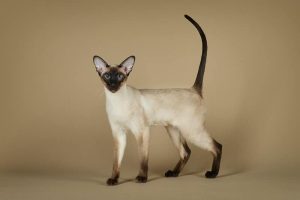Siamese cats are known for their striking appearance, striking blue almond-shaped eyes, and vocal, affectionate personalities. Here’s more information about Siamese cats:

siamese cat
- Physical Appearance: Siamese cats have a sleek, slender body with a short coat. Their fur is typically cream or fawn with color points on the ears, face, paws, and tail. The color points can come in various shades, including seal, chocolate, blue, and lilac.
- Eye Color: One of the most distinctive features of Siamese cats is their deep blue, almond-shaped eyes. Their bright blue eyes are one of the breed’s hallmarks.
- Temperament: Siamese cats are known for their outgoing and vocal personalities. They are highly social and enjoy interacting with their human family members. They are affectionate and often seek attention and companionship. Siamese cats are not shy about using their voices to communicate their needs and desires.
- Intelligence: Siamese cats are intelligent and inquisitive. They enjoy mental stimulation and benefit from interactive toys and puzzle games that challenge their minds.
- Vocalization: Siamese cats are renowned for their loud and melodious voices. They are often described as “talkative” cats and will engage in conversation with their owners.
- Health Considerations: Siamese cats are generally healthy, but they can be prone to certain genetic health issues, such as dental problems and respiratory issues. Regular veterinary check-ups and dental care are important for their well-being.
- Origin: Siamese cats are one of the oldest recognized cat breeds, originating in Thailand (formerly Siam) hundreds of years ago. They were considered sacred and were kept as royal pets.
- Popularity: Siamese cats are a popular breed due to their striking looks and affectionate nature. They have a strong following among cat enthusiasts worldwide.
- Indoor Living: Siamese cats are best suited for indoor living to protect them from potential hazards and to ensure their safety. They thrive in a loving and stimulating indoor environment.
- Adoption: Consider adopting a Siamese cat from a rescue organization or shelter. Siamese cats sometimes become available for adoption, providing a loving home to a cat in need.
Siamese cats make wonderful companions for individuals and families who appreciate their beauty and engaging personalities. They require social interaction and mental stimulation, so be prepared to spend time with them and provide opportunities for play and enrichment. When acquiring a Siamese cat, choose a reputable source that prioritizes the welfare of their cats and follows ethical breeding or adoption practices.

siamese cat
siamese twins siamese cat
Siamese twins, also known as conjoined twins, are identical twins who are physically joined together at birth. This rare occurrence happens when the fertilized egg, which typically splits into two embryos during early development, only partially separates. As a result, the twins share some or all of their bodily structures.
Here are some key points about Siamese twins:
- Medical Terminology: The term “Siamese twins” was coined in the 19th century and was based on Chang and Eng Bunker, conjoined twin brothers born in Siam (now Thailand) in 1811. The medical term for conjoined twins is “conjoined” or “conjoined twins.”
- Types of Conjoined Twins: Conjoined twins can be classified based on the parts of their bodies that are connected. Some common types include thoraco-omphalopagus (connected at the chest and abdomen), craniopagus (connected at the head), and pygopagus (connected at the buttocks).
- Incidence: Conjoined twins are extremely rare, occurring in approximately 1 in 200,000 live births. The exact cause of conjoinment is not well understood, but it is believed to be due to a combination of genetic and environmental factors.
- Medical Challenges: Conjoined twins often face complex medical challenges. Their treatment and potential for separation depend on the extent of their connection and the vital organs they share. Separation surgeries, if feasible, are highly complex and require a skilled medical team.
- Quality of Life: The quality of life for conjoined twins varies depending on their specific situation. Some may lead relatively normal lives after separation, while others may face significant physical and medical limitations.
- Ethical and Moral Considerations: Decisions regarding the care, treatment, and potential separation of conjoined twins can be ethically and morally complex. These situations often involve input from medical professionals, ethicists, and the twins’ families.
- Historical Cases: There have been several famous cases of conjoined twins throughout history, including Chang and Eng Bunker (the original “Siamese twins”), Millie and Christine McCoy, and Abby and Brittany Hensel, among others.
- Support and Advocacy: Various support groups and organizations exist to provide resources and support for families of conjoined twins. These organizations aim to assist families in navigating the unique challenges they may face.
It’s important to recognize that each case of conjoined twins is unique, and decisions regarding their care and treatment should be made with careful consideration of their specific medical, ethical, and emotional circumstances.
siamese
It seems like you’re looking for information related to “Siamese.” “Siamese” can refer to different things, so I’ll provide information on a few different topics related to “Siamese”:
- Siamese Cat: The Siamese cat is a distinctive and popular breed known for its striking appearance, blue almond-shaped eyes, and vocal personality. They have a short, sleek coat with color points on their ears, face, paws, and tail. Siamese cats are known for being social, intelligent, and affectionate pets.
- Siamese Twins: Siamese twins, also known as conjoined twins, are identical twins who are physically joined together at birth due to incomplete separation during fetal development. This is a rare occurrence and presents unique medical challenges and ethical considerations.
- Siamese Fighting Fish: Siamese fighting fish, also known as Betta fish, are a popular and colorful aquarium fish species. They are known for their vibrant colors and long, flowing fins. Betta fish are often kept as pets and are known for their territorial and aggressive behavior, especially towards other male Betta fish.
- Siam (Thailand): Historically, Siam was the name for the Kingdom of Thailand before it was renamed. It is located in Southeast Asia and has a rich cultural heritage, including its own breed of cats, the Siamese cat.
If you have a specific question or topic related to “Siamese” that you would like to know more about, please provide more details, and I’ll be happy to provide further information.

